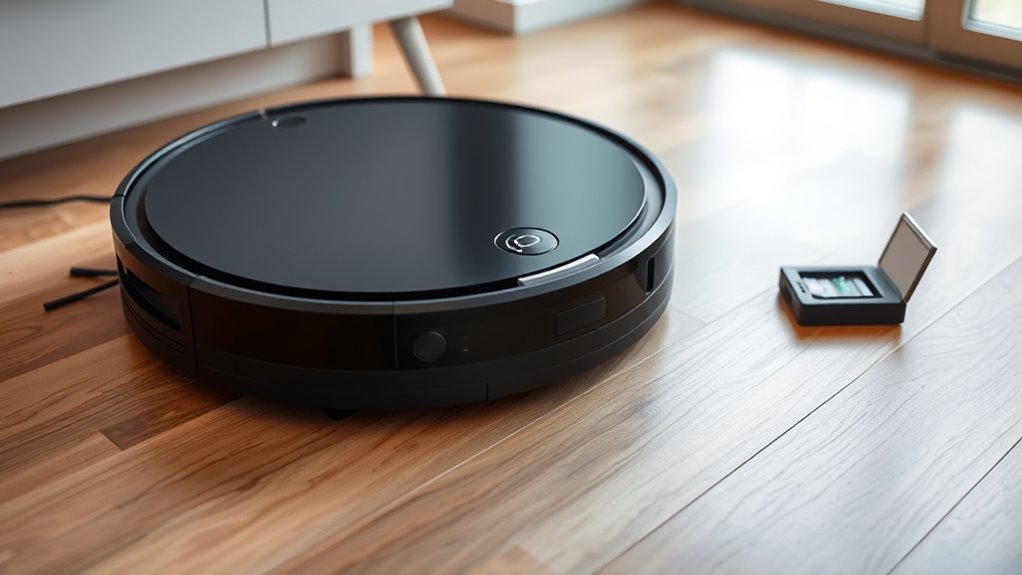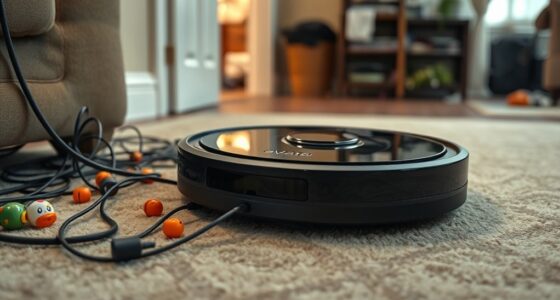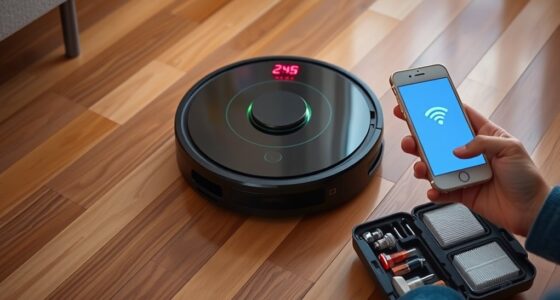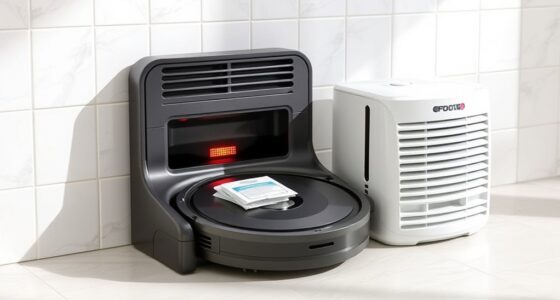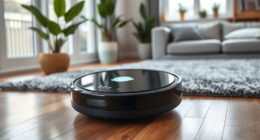Your robot vacuum’s battery life depends on proper care and maintenance. Myths suggest batteries last forever, but they naturally degrade over time, so replacing them when necessary helps restore performance. Avoid overcharging, keep batteries cool, and use original chargers to extend lifespan. Regularly clean contacts and keep the device in a dry environment. Following these tips can markedly improve battery health. For more insights and expert advice, explore the essential care strategies in store for you.
Key Takeaways
- Battery capacity naturally declines over time, reducing runtime; timely replacement restores performance.
- Proper charging habits, like unplugging after full charge, help maintain battery health and longevity.
- Avoid fully discharging the battery; keep charge levels between 20% and 80% for optimal lifespan.
- Environmental factors such as heat and humidity accelerate battery degradation; store vacuum in cool, dry places.
- Using compatible, high-quality batteries and chargers ensures safety, efficiency, and longer battery life.
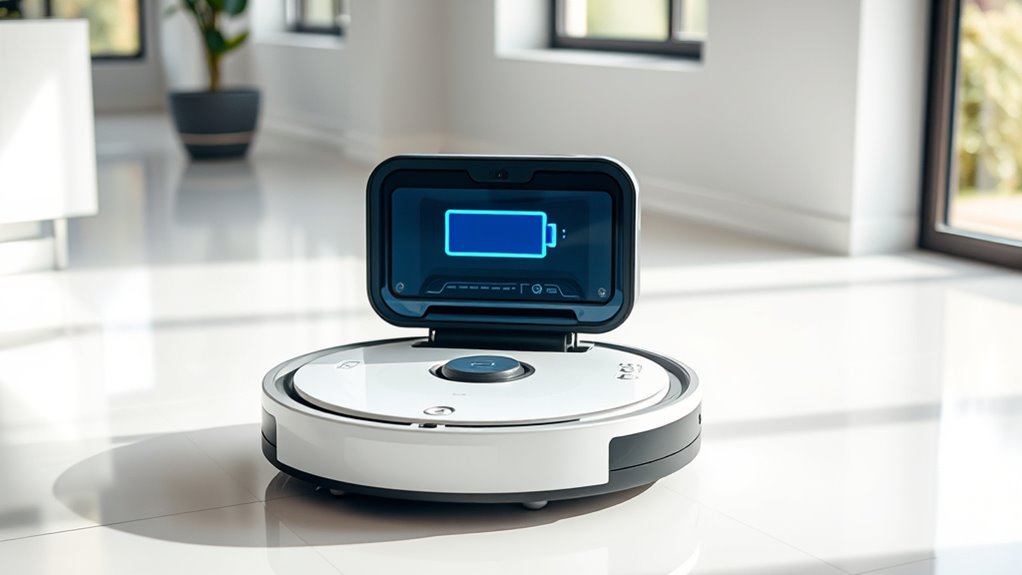
Have you ever wondered how long your robot vacuum’s battery lasts during a cleaning session? The answer depends on several factors, but understanding how to care for your device can considerably extend its lifespan. One of the most common concerns is when to consider battery replacement. Over time, batteries naturally lose capacity, meaning your vacuum might not run as long as it used to. If you notice your robot consistently stops mid-clean or doesn’t hold a charge as long, it could be time to replace its battery. Replacing the battery can restore your vacuum’s runtime without the need for a costly new device, but it’s vital to choose the right battery model for your robot. Properly installing it and following manufacturer recommendations guarantees ideal performance.
Charging efficiency is another essential aspect that affects your robot vacuum’s battery life. When you frequently plug it in and let it charge, it’s tempting to leave it on the charging dock even after it’s fully charged. However, overcharging can harm the battery’s health over time. Modern robot vacuums often have intelligent charging systems that stop charging once full, but it’s still a good idea to unplug it after the battery reaches 100%. If your robot takes longer to charge or seems to be charging inefficiently, check the charging contacts for dust or debris, which can interfere with proper power transfer. Using the original charger supplied by the manufacturer also helps maintain charging efficiency because third-party chargers might not deliver the correct voltage or current.
Another tip to maximize battery life is to avoid letting the battery drain completely before recharging. Lithium-ion batteries, common in most robot vacuums, perform better when kept between 20% and 80% charge. Regularly allowing the battery to fully discharge can reduce its capacity over time. Additionally, keeping your robot in a cool, dry place when not in use helps preserve battery health. Heat, in particular, accelerates battery degradation, so avoid leaving your vacuum in direct sunlight or hot environments. Understanding battery chemistry can help you better care for your device’s power source and extend its overall lifespan.
Frequently Asked Questions
How Often Should I Replace My Robot Vacuum Battery?
You might wonder how often to replace your robot vacuum battery. Typically, batteries need replacement after about 12-18 months, depending on usage and maintenance. Proper battery maintenance can extend its lifespan, delaying the need for battery replacement. Keep an eye on battery performance; if your vacuum struggles to clean or holds a charge for less time, it’s time to think about replacing the battery. Regular care guarantees the best performance.
Do Different Brands Have Significantly Varying Battery Life?
Imagine you’re comparing brands like Dyson and iRobot; you notice Dyson’s battery longevity often outlasts iRobot’s. Brand comparison shows significant differences in battery life due to design, quality, and battery technology. Some brands prioritize longer-lasting batteries, while others focus on cost. So, yes, different brands can have noticeably varying battery longevity, influencing how often you’ll need replacements or recharges for your robot vacuum.
Can I Upgrade My Robot Vacuum’s Battery Myself?
You can sometimes upgrade your robot vacuum’s battery yourself, but it depends on your model. Check if the replacement battery matches the original in battery capacity and supports the same charging cycles to guarantee peak performance. Be sure to follow the manufacturer’s instructions carefully, as improper installation can damage the device or reduce battery life. If you’re unsure, consulting a professional or the manufacturer is a safe bet.
Is a Longer Battery Life Always Better for Cleaning?
When it comes to battery life, more isn’t always better; don’t put all your eggs in one basket. A higher battery capacity can extend cleaning time, but it might also add weight or reduce maneuverability, affecting cleaning efficiency. Consider your space and needs. Sometimes, a balanced battery life guarantees your robot vacuum cleans effectively without unnecessary bulk, proving that quality beats quantity every time.
How Does Battery Age Affect Vacuum Performance Over Time?
As your robot vacuum ages, battery degradation causes performance decline over time. You’ll notice it struggles to clean as efficiently or runs out of power faster. This happens because the battery’s capacity diminishes, reducing runtime and suction power. To keep your vacuum performing well, you should regularly maintain the battery, avoid overcharging, and consider replacing it when performance drops markedly. Proper care extends its effective lifespan.
Conclusion
Don’t let battery worries hold you back from enjoying a spotless home. With proper care and understanding, your robot vacuum’s battery can last for years, saving you time and money. Some might think replacing batteries is costly, but regular maintenance actually extends its lifespan considerably. Keep your vacuum clean, avoid overcharging, and follow manufacturer tips—your device will perform reliably, making cleaning effortless. So, trust in your robot’s durability and let it do the hard work!
